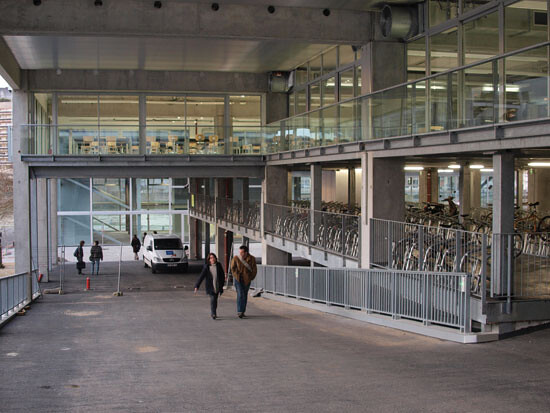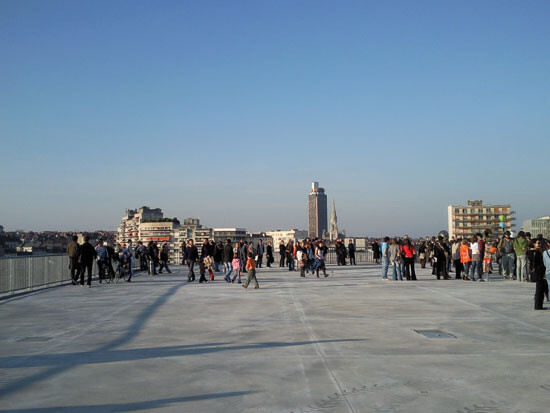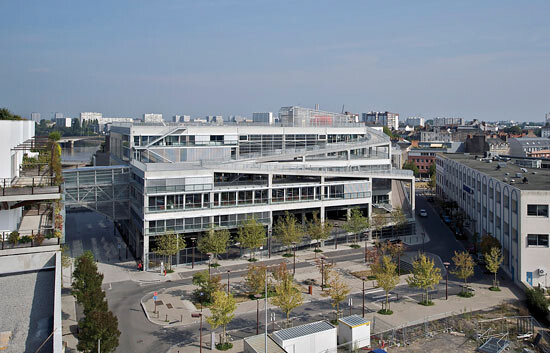On a rainy day in spring 2014, I visited the Nantes School of Architecture designed by Lacaton & Vassal Architects. Opened in 2009, it was the result of a competition held in 2002 to replace the original school from the early 1970s, which had become too small to house the expanded study program and the growing number of students. The Nantes School of Architecture is one of about twenty Écoles Nationales Supérieures d’Architecture in France, and houses about one thousand students. I had heard a lot about this project and seen many images, but I had difficulty imagining its spaces and wanted to see it for myself. It is located on the Île de Nantes, the former harbor area of this busy and wealthy city in northwest France. It is close to the old city center. Its neighborhood features the mixture of offices, housing, cultural venues, and vacant lots typical of gentrified waterfront areas, with their aura of both factory ruin and construction site.
As I approached the building, I was struck by the way it relates to the ground. The asphalt from the street seemed to continue seamlessly into the entry hall. And in fact there is no underground construction—the reinforced concrete grid sits directly on the ground. Heading towards the entrance, I passed by a ramp which gently leads to the upper decks and which can be used by pedestrians and bicycles, but also cars and trucks. The motif of traffic animates the entire space of the school. Circulation literally seems to be running through the various floors. Instead of planning a separate parking lot at a distance, or hiding it underground, the architects intertwined parking, teaching, learning, and administration. By declining to build a cellar, an attic, and a subterranean parking lot, the architects put all the features of a school’s life on the table. The way of working is part of the work, so to speak.


As I went up the ramp I had the impression of entering the school through the back door. I immediately became sympathetic to the building. Instead of being dwarfed and intimidated by a monumental entrance structure, as with many institutions of higher education, I felt like an insider, like someone who knew the shortcuts, who was familiar with the place and was free to approach its entrance via the garage. Almost like entering a private flat where bicycles and kids’ rubber boots clog the entrance, I was part of a non-ceremonial transitional area between outside and inside, public and private, a common zone where students and teachers, administrators, and passersby meet.
I found it easy to navigate the building and orient myself. Unlike most universities—for instance, my own in Zürich—where a Kafkaesque labyrinth of corridors absorbs one’s energy, I never felt lost. Connections were simple, and some spaces, such as the main lecture hall, could be perceived from various parts of the building because their volumes intersected with the other spaces in the school. Mostly, I experienced my visit as an aesthetic pleasure, as a promenade architectural—an itinerary full of surprising vistas and spatial events. The rather narrow entrance area, with its dark floor and slightly somber atmosphere, opened up in a spectacular fashion to a very generous two-story mezzanine, which serves as an exhibition space and links the class areas to the library and the administrative offices. The architects work with contrasts of dark and light-filled zones, narrow and wide spaces, low and high ceilings, ramps, and stairs. There are many spectacular views, for instance towards the very large workshops which connect directly to the street so that cars and trucks can enter.


The most unexpected view is the one from the roof terrace over the river and towards the city. The terrace is a generous parking deck accessible both via the ramp and the stairwells. I immediately recalled the emblematic photographs from the newly built Bauhaus in Dessau in the late 1920s, with students and teachers dancing and playing music on the roof terrace, triumphing over the old Beaux-Arts education. Although it was pouring rain and everybody remained in the classrooms, I had no difficulty imagining students gathered in groups under the open sky, discussing their work, questioning the teachers, or enjoying a party after exams. It was easy to imagine how the curriculum worked, with the building alternating between lecture halls, drawing rooms, places to read, and places to relax.
The counterpart of the roof terrace is the main lecture hall on the ground floor. With its asymmetrical seating and balconies, it resembles the interior of an opera house. The outer walls are covered with polycarbonate sheets, and curtains block the light if needed. The entire façade is made of sliding doors and can be opened towards the street. Whereas the publicly accessible roof links the building to the sky, the lecture hall links it to the ground. I imagined how teaching would function in such a situation, with people oscillating between the inside and outside of the school. In my euphoric mood of relating everything I saw to the realm of ideas, I recalled the opposition between Platonic and Aristotelian philosophy, depicted by Raphael in his School of Athens, with Plato pointing towards the sky and Aristotle to the ground.


Beyond Sustainability
In fact, there is much to be said about the aesthetics of Lacaton & Vassal’s architecture, the formal quality of the spaces it produces—the materiality, the iconography, and the scenography. The overlapping surfaces alone offer a huge variety of spatial and chromatic experiences. There might be merely functional and economic reasons to install cables and tubes openly, instead of hiding them behind a concrete wall or under a ceiling. They simultaneously distinguish the building from and relate it to its surroundings, making it look extraordinary and ordinary at the same time. Something similar can be said about the membranes. The opaque polycarbonate sheets, with their undulating surface frame, blur and distort the environment, allowing us to see it differently. During the day they produce innumerable effects of light and shade for those working inside the building. For those approaching it, these membranes open different perspectives on the inside, such as the concrete structure supporting the auditorium seating, material stacked in the workshops, as if one were passing a series of nature morte paintings.
Perhaps I was driven to such formal associations because Lacaton & Vassal’s work is usually described in very prosaic terms. Most interpreters of the project highlight the fact that Lacaton & Vassal Architects offer more space than the brief asked for. Instead of ten thousand square meters required by the competition program, they proposed almost double the space for the same price. The architects thus further developed the basic method they had established in their Maison Letapie in Floirac, France (1993), the University of Arts & Humanities, Grenoble (1995/2001), the House in Coutras (2000), and the Social Housing in Mulhouse (2005): expanding the usable space by adding cheap conservatories. Using a standard support system—known, for instance, from IKEA storage buildings, which allow for important loads—the structure is open to future rearrangement. No wonder that a central quality of their work is identified as “sustainability.” As Nathalie Janson put it in a brochure published when Lacaton & Vassal received an award:
Paradoxically, it is precisely this primal move to create excess space that makes the building ecologically, socially, and financially sustainable. The building’s double-height unprogrammed volumes, designed at the architect’s discretion, provide the school with adaptable and multifunctional spaces that will allow the building to be repurposed rather than destroyed and built anew.1


The Intangible Infrastructure of Higher Education
In the second half of the nineteenth century, higher education was one of the key issues in the emergence of the European nation-states. The young nation-states cherished science and technology as the main engines of economic progress and social coherence. They considered public universities to be the very basis of this process. The democratization of European nation-states during the twentieth century—especially in the second half of the century, with the establishment of the welfare state—led to a rapid expansion of higher education. Many new universities and research institutes were founded, with new campuses built in and outside cities. The tension between the idea of higher education as a privilege for a small elite and the need to include a large part of the population in the “mass university” marked the discourse on higher education in the boom years after World War II, and was one of the reasons for the student revolts of 1968. Since the new millennium, Europe has once again been expanding higher education, now erasing the difference between nation-states in the guise of the Bologna Process. In some European countries, such as Ireland, more than half the population had a tertiary education in 2013, and the European average is 40 percent.2
The “Bologna Declaration” of June 19, 1999 states that
a Europe of knowledge is now widely recognized as an irreplaceable factor for social and human growth and as an indispensable component to consolidate and enrich European citizenship, capable of giving its citizens the necessary competences to face the challenges of the new millennium, together with an awareness of shared values and belonging to a common social and cultural space.3
The construction of a Europe-wide system of higher education was considered necessary if European higher education wanted to acquire a “world-wide degree of attraction equal to our extraordinary cultural and scientific traditions”—in other words, to remain competitive with the private higher education sector in the United States and the dynamic development of higher education in Southeast Asia. The aim of the meeting was to achieve within a decade the objectives of having easily understandable and comparable degrees; a curriculum based on two main cycles, undergraduate and graduate; a system of credits; the promotion of the mobility of students, teachers, researchers, and staff; and assurances of comparable quality.
Opinions on the Bologna Process are divided. Most politicians applaud the process because of its role in advancing the unification process in Europe and its promise of making research and teaching manageable. Without a doubt, the Bologna Process has made students more independent of the arbitrariness of professors, offering them more mobility and clearer rules. Students can more easily plan their studies and change schools, and the experience of living abroad for a semester or two is advantageous for their life and career. While the majority of students favor the Bologna Process, most professors are skeptical. Particularly in the German-speaking areas of Europe—Germany, Switzerland, and Austria, with their long tradition of federalist, decentralized higher education—not only professors but also a growing number of administrators and university representatives harshly criticize the process. According to its critics, Bologna is a failure. It has increased workloads and the influence of bureaucracy, and it has diminished individual autonomy and the motivation and intellectual curiosity of students. The “employability” of European students being one of the main goals of the process, the mainstream of left-liberal academics deplores the economization of higher education. Instead of preparing students for their lives, say these academics, the system turns them into ETCS (European Credit Transfer System) hunters.
The “Bologna Process,” or simply “Bologna,” is named after the city where the first meeting about the education reforms took place. Bologna is also home to one of the oldest universities in the world. But the Bologna Process does not have a face. What is the role of architecture in this process? Is there a spatiality of the transformation of higher education? Is there an architecture that depicts “Bologna”? While the mantra of urbanization has replaced the ideology of progress, and while we hear often about the growth of urbanization—“10 percent of the population lived in cities in 1900, 50 percent are living in cities in 2007, and 75 percent will live in cites in 2050”4—the growth of academization seems to be detached from issues of architecture and urbanization. The influential book The Endless City is exemplary of the ongoing trend of focusing on the city. It features reams of data about economics, density, and mobility in cities, but the topic of higher education is neglected; the index does not even mention the word “university.” In the architecture world there are, admittedly, sporadic discussions about issues such as the urban campus, individual signature buildings at research institutes, and libraries or student housing.5 But such projects concern mainly specialists and are overshadowed by more spectacular manifestations of architecture such as stadiums, concert halls, and museums, and more appealing topics such as ecology, gentrification, and densification.
I would argue that the role of architecture as intangible infrastructure in the realm of higher education is both crucial and repressed. Perhaps the utilitarian nature of the spaces of higher education stands in the way of perceiving them as elements that are of interest to architects. The spaces of lecture halls and libraries, admission offices and photocopying booths, gym halls and bicycle stands, cafeterias and computer rooms, inform the daily life of students and teachers. Yet the constant transformation necessary for their functioning, the adaptation to changing numbers of students, the reshuffling of institutes and chairs, the permanent reorganization of staff hierarchies—these factors make the spaces of higher education unattractive to Architecture with a capital “A.” Unlike political institutions and private companies, there is little need for higher education to be “represented” architecturally. Unlike private universities, which traditionally commission buildings by famous architects and attract students with the visual quality of their spaces, there is no such thing as a brand in the realm of public higher education. Both the “corporate identity” and the “façade” are secondary in a field where value is measured by reputation, trust, and credibility, and is expressed in rankings lists.
This might be one of the reasons for the indifference of most higher education officials to the quality of the architecture on their campuses. The other reason is probably political: since public universities depend almost entirely on taxpayer money, they try to prevent the impression of wasting it on anything that is not entirely necessary. This indifference to the architectural expression of higher education is not unique to our present situation, but goes far back in history. In his dissertation about the early history of the University of Leiden, Gregory Grämiger wrote that at the time of the university’s founding in the late sixteenth and seventeenth century, the focus was on the transformation of already existing buildings—namely, a church—in order to provide useful spaces for libraries, exhibition spaces, laboratories, and an anatomy theater. There was neither a budget nor a need to invest in the exterior look of the newly funded university. In order to attract students, it relied on word-of-mouth and on prints showing the laboratories, the library, and the fencing hall. The exterior aspect of the university, and its architectural quality as a whole, was neglected.6
Trucks in the Classroom
There are two conflicting principles battling for the soul of the Bologna Process. One is economic. From this perspective, the Bologna Process is about exploitation under the conditions of immaterial labor, about preparing students for the market, about standardization, interchangeability, homogenization, profitability. The other is idealistic. From this perspective, the Bologna Process is about emancipating students from the professorial hierarchy, about social and spatial mobility, about mutual tolerance and experience, about the sharing of knowledge, about unity and a better future. In the “Sorbonne Joint Declaration” of 1998, which predates the Bologna Declaration, the ministers of education in France, Germany, Italy, and the United Kingdom stated:
The European Process has very recently moved some extremely important steps ahead: relevant as they are, they should not make one forget that Europe is not only that of the Euro, of the banks, and the economy: it must be a Europe of knowledge as well.7
It is exactly these two conflicting principles that can be perceived in the Nantes School of Architecture, a project whose history—from the design competition in 2002 to the building’s completion in 2009—runs more or less parallel with the Bologna Process. Or, put differently: while the conflict is difficult to articulate on a conceptual level, it is manifest in the spatiality of the school. The constant questioning and open-ended adaptability of the building is intrinsically linked to the Bologna Process. Indeed, the architects emphasize these values in their own description of the building:
On the initiative of the students, teacher or visitor, these spaces become the locus of possible appropriations, events, and programming. At any one moment the adaptation of the school to new interventions and its reconversion is possible. Like a pedagogical tool, the project questions the program and the practices of the school as much as the norms, technologies, and its own process of elaboration.8
Couldn’t the building itself be read as an allegory of the Bologna Process? Its location on the Île de Nantes makes it appear as if it emerged from the terrain vague, from the ruins of deindustrialization. With its concrete grid reminiscent of warehouses and factories, it resembles a reused industrial building.
But as one walks through the spaces of the school, it becomes obvious that there is no dialogue between old and a new. Rather, the building is about an interaction between architecture and infrastructure. The collision between its highly refined composition of spaces and materials, and the robustness of its infrastructure, produces a tension that cannot be resolved. It is an internal contradiction that is also characteristic of “Bologna” and other processes related to the European Union. Like the brutalism of many buildings from the 1960s and 1970 that were intrinsically related to the welfare state, the Nantes School of Architecture resonates with the spaces of European bureaucracy in “Brussels” and “Paris,” as well as with the innumerable investments in roads, bridges, and other traffic infrastructure that go with the European Union. To understand that traffic and higher education are inseparably linked is one of the lessons that one learns from visiting the school. The presence of transport containers on various decks of the school, of caravans in the exhibition hall, and even of a boat and a truck in the workshops on the ground floor, is revealing for a situation that is far beyond the era of the ivory tower.
“Bologna,” in the end, means that studying gets cheaper. Europe gets more students for less money, in smaller spaces, in a shorter amount of time than before the introduction of the reforms. Architecture cannot change the political framework, but it can be conscious about the conditions, and it does not have to fully identify either with the client or the program. The Nantes School of Architecture demonstrates that architecture does not have to subscribe to the ideology of reduction, scarcity, and control, although it has to be conscious of it, letting us see more than what the political decision-makers say. It is therefore not only one among many places where future architects are trained. It is also a place where the autonomy of architecture is tested.
Nathalie Janson, “Lacaton & Vassal Architects: Sustainable space makers,” in Nantes School of Architecture, University Building in France (Zürich: Holcim Foundation for Sustainable Construction, 2011), 22–69; 26.
OECD data →.
“The Bologna Declaration of 19 June, 1999, Joint declaration of the European Ministers of Education.” See the website Bologna Process—European Higher Education Area →.
To A quote the from the cover of The Endless City: The Urban Age Project by the London School of Economics and Deutsche Bank’s Alfred Herrhausen Society, ed. Ricky Burdett and Deman Sudic (London: Phaidon, 2007). The book echoes both in rhetoric and design OMA’s book S, M, L, XL, first published in 1995.
See Alexander den Heijer and George Tzovlas, The European Campus: Heritage and Challenges (TU Delft, 2014).
Gregory Grämiger, “Verortungen von Wissen: Die Räume und Sammlungen der Universität Leiden, 1575-–1700, dissertation, ETH Zürich (manuscript), 2014.
“Sorbonne Joint Declaration: Joint declaration on harmonizing of the architecture of the European higher education system, Paris, the Sorbonne, May 25, 1998.” See the website Bologna Process—European Higher Education Area →.
See →.
